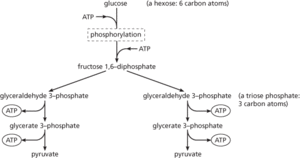The series of biochemical reactions in which glucose is broken down to pyruvate with the release of usable energy in the form of ATP. One molecule of glucose undergoes two phosphorylation reactions and is then split to form two triose-phosphate molecules. Each of these is converted to pyruvate. The net energy yield is two ATP molecules per glucose molecule. In aerobic respiration pyruvate then enters the Krebs cycle. Alternatively, when oxygen is in short supply or absent, the pyruvate is converted to various products by anaerobic respiration. Other simple sugars, e.g. fructose and galactose, and glycerol (from fats) enter the glycolysis pathway at intermediate stages. The pathway was elucidated by Gustav Embden (1874–1933) and Otto Meyerhof (1884–1951) in the early decades of the 20th century.
The series of biochemical reactions in which glucose is broken down to pyruvate with the release of usable energy in the form of ATP. One molecule of glucose undergoes two substrate-level phosphorylation reactions and is then split to form two triose-phosphate molecules. Each of these is converted to pyruvate. The net energy yield is two ATP molecules per glucose molecule. In cellular respiration pyruvate then enters the Krebs cycle and undergoes partial or complete oxidation, ultimately driving an electron transport chain to generate more ATP. Alternatively, the pyruvate is converted to lactic acid or alcohol by fermentation. Other simple sugars, e.g. fructose and galactose, and glycerol (from fats) enter the glycolysis pathway at intermediate stages. Compare gluconeogenesis.

The principal stages of glycolysis
- hyperglycaemia
- hypergolic
- hypergolic fuel
- hypergraph
- hyperinflation
- Hyperion
- hyperlink
- hypermedia
- hypermetamorphosis
- hypermetropia
- hypermobility
- hypermorphosis
- hypernetted chain approximation
- hypernova
- hypernucleus
- hyperon
- hyperparameter; hyperprior
- hyperparasite
- hyperplane
- hyperplasia
- hyperpolarization
- hyperpycnal flow
- hyperreality
- hyperreals
- hypersensitivity